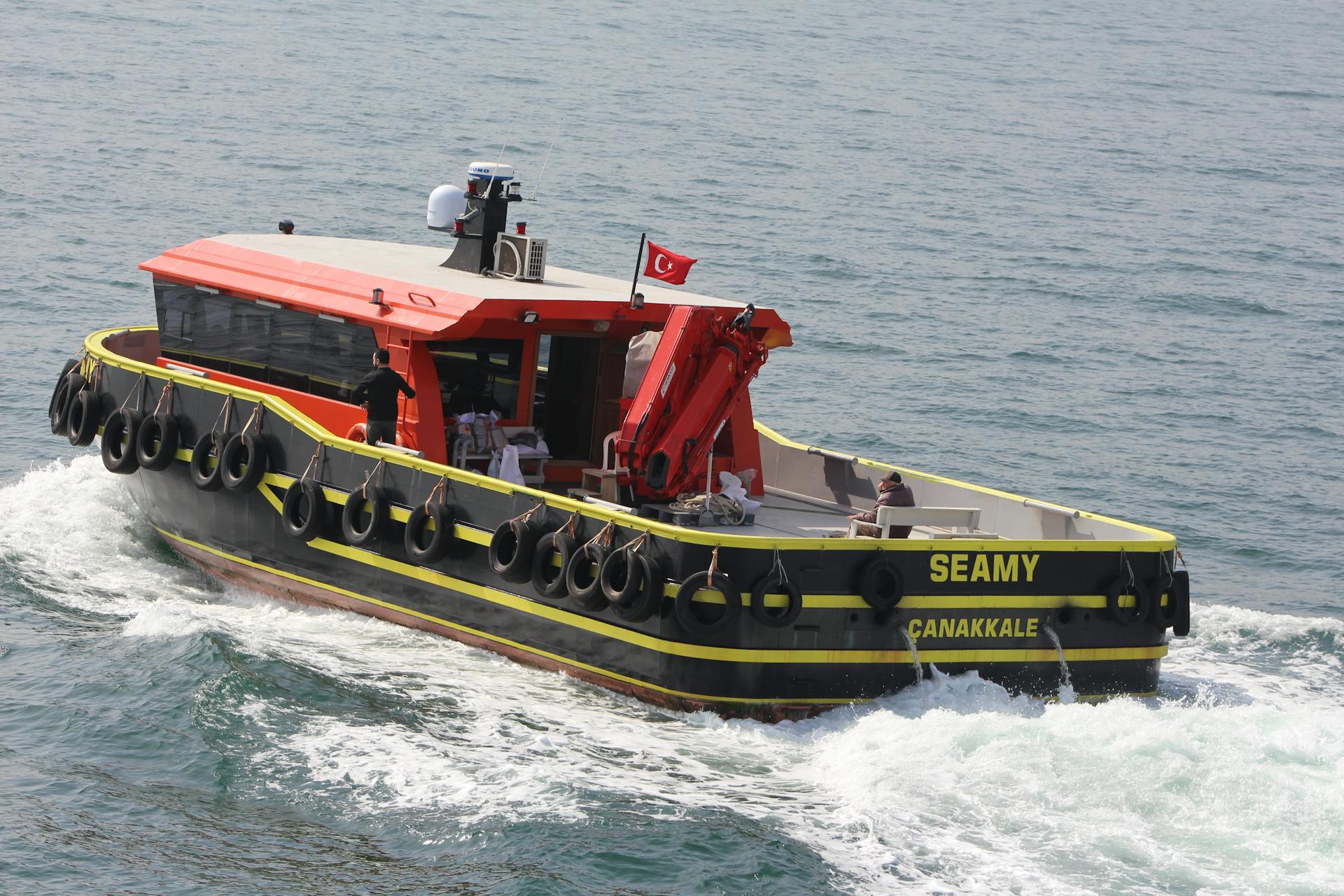
The use of shore to ship power systems can significantly reduce greenhouse gas emissions in the shipping industry.
These systems allow ships to plug into onshore power grids while in port, eliminating the need for diesel generators and reducing emissions by up to 98%.
This technology is especially beneficial for ships that spend a significant amount of time in port, as it can greatly reduce their carbon footprint.
By leveraging shore to ship power systems, ship owners and operators can make a substantial impact on the environment.
On a similar theme: Order Picking Systems
Sustainable Shipping
The STS Power System is a game-changer for reducing emissions in shipping. It's developed by eCap Marine, a company that thinks outside the box.
This system utilizes the distributable capacity from Ship-to-shore STS Crane for Onshore Power Supply (OPS) purpose. This technology can be integrated into existing terminal infrastructure.
By using shore power, container ships can instantly reduce their emissions from diesel auxiliary engines. This is especially beneficial for port cities, where air pollution is a major concern.
The STS Power System is an ingenious innovation that can make a significant impact on the environment.
Igus Solutions
Igus Solutions play a crucial role in shore to ship power systems, providing reliable and efficient energy transfer between vessels and shore-based facilities.
Igus's energy chain systems, such as their E4.1 and E4.2 models, are designed to withstand harsh marine environments and can be easily installed and maintained on ships and piers.
Their products are used in various applications, including offshore wind farms, oil and gas platforms, and cruise ships, where power supply reliability is critical.
Worth a look: Holland America Alaska Ships
Igus Solutions for Terminals and Vessels
Igus Solutions for Terminals and Vessels are designed to provide flexible and durable power connections.
The igus Mobile Shore Power Outlet can travel long distances, up to 800 meters or more, making it perfect for container terminals and vessels.
One of the key benefits of igus solutions is their long service life and cost-efficient design.
For container terminals and vessels, igus offers mobile shore power connections that provide full flexibility.
A slip ring-free cable guidance system is also available, which helps extend the life of the power connections.
Here are some key features of igus solutions for terminals and vessels:
- Flexible and durable
- Mobile shore power connections for full flexibility
- Slip ring-free cable guidance systems for a long service life
Connection Box
A connection box, also known as a utilization station or shore power cabinet, is a crucial component of a shore power installation. It's usually placed near the edge of the quay and can be installed at a fixed location or be movable.
The choice of the right connection box depends on the type of ship and the specific conditions at the quay. This means that the box needs to be tailored to the needs of the vessel and the installation site.
A connection box allows a ship to be connected to the power, if necessary, via the cable management system. This is a vital feature for ships that require a reliable and efficient power supply.
Discover more: Shore Power Connection
E-Spool and E-Chain
The e-chain reel is a game-changer for shore to ship power systems. It offers flexibility for both existing and new shore power connections, making it a versatile solution.
One of the key benefits of the e-chain reel is its protected cable guidance. This feature increases safety and durability, which is essential for reliable power transmission.
The e-chain reel's flexibility also makes it easier to manage cables, reducing the risk of damage or tangling.
Here are some key features of the e-chain reel:
- Flexibility for existing and new shore power connections
- Protected cable guidance
- Increases safety and durability
LNG and Barge Connection
Connecting an LNG power barge to shore power systems offers numerous benefits. One of the key advantages is pollutant reduction.
LNG power barges can run for longer periods without refueling, which increases their service life and makes them a cost-efficient option. This is a significant advantage over traditional fuel sources.
Connecting an LNG power barge also increases safety. By reducing the need for traditional fuels, the risk of fires and explosions is minimized.
Here are some of the key benefits of connecting an LNG power barge:
- Pollutant reduction
- Longer service life and cost-efficient
- Increases safety
Energy Management System
Our Energy Management System (EMS) is a game-changer for reliable power supply. It calculates when and which energy source can be optimally utilized, taking into account factors like the power grid's characteristics, chosen energy storage system, and load demands.
This intelligent system ensures you always have a reliable power supply at the lowest cost. The EMS uses algorithms to make informed decisions about energy usage.
The EMS can be integrated with existing terminal infrastructure, making it a seamless addition to your shore-to-ship power system. This means you can take advantage of its benefits without disrupting your operations.
By utilizing distributable capacity from Ship-to-shore STS Crane for Onshore Power Supply (OPS) purposes, you can instantly reduce emissions from diesel auxiliary engines. This is especially beneficial for container ships during their layover in ports.
The EMS plays a crucial role in reducing emissions and harmful air pollution in port cities. By optimizing energy usage, you can contribute to a cleaner and healthier environment.
Installation and Maintenance
The ShorPOWER SHF shore to ship power system is designed to be installed in a variety of locations, offering flexibility and convenience.
Its compact aspect ratio and form factor allow for installation in small spaces, making it ideal for yachts and other vessels with limited onboard space.
The system's lightweight design also makes it easier to install and move around, reducing the hassle and expense associated with traditional power systems.
Its aesthetic yacht finish not only looks great but also adds value to your vessel at resale, making it a worthwhile investment.
Atlas Marine Systems Ships 5,000th Unit

Atlas Marine Systems has reached a milestone with the delivery of their 5,000th unit, a significant achievement in the industry.
The Ultra 120kVA ShorPOWER unit was installed on M/Y, marking a major accomplishment for the company.
Atlas Marine Systems has been in the business for a long time, and this milestone is a testament to their hard work and dedication.
The company's commitment to quality and reliability has paid off, as evident in the success of their 5,000th unit.
Intriguing read: United States Committee on the Marine Transportation System
Ease of Installation
The ShorPOWER SHF is designed to be installed either vertically or horizontally, giving you flexibility in choosing an installation location.
This feature allows for installation in small spaces, making it perfect for yachts and other smaller vessels. Its compact design also adds value at resale, making it a smart investment.
The ShorPOWER SHF's lightweight and compact design makes it easy to install, even in tight spaces. Its aesthetic yacht finish ensures it looks great on your vessel.
If you're looking to install a shore power system, consider the flexibility of the ShorPOWER SHF's installation options.
Remote Monitoring

With Cat Connect, you can monitor the operation of your shore power system 24/7. From your phone, computer, or tablet, you can immediately identify potential issues.
You can gain valuable insights into costs, which can help you make informed decisions about your energy usage. This is especially useful for tracking expenses over time.
Identifying potential issues remotely allows you to resolve problems before they become major issues. This can save you time, money, and stress in the long run.
Technology and Innovation
Technology and Innovation is the backbone of shore to ship power systems. The integration of advanced technologies has significantly improved the efficiency and reliability of these systems.
The use of high-voltage direct current (HVDC) transmission technology has been instrumental in reducing energy losses and increasing power transfer capacity. This has enabled ships to receive power more efficiently, reducing the strain on the system and improving overall performance.
The implementation of advanced control systems has also played a crucial role in optimizing power distribution and reducing energy waste. By continuously monitoring and adjusting power flow, these systems can ensure that ships receive the power they need exactly when they need it.
Additional reading: Cargo Ships Canada
Module
The shore power module is a crucial component of shore power technology. It's an integrated system that houses a transformer and an inverter in a single container.
A suitable module is selected based on the required power, frequency, and voltage. This ensures that the module can handle the specific needs of each shore power installation.
Direct connection to the ship is possible, but a connection box can be used if that's not feasible. This flexibility makes shore power modules a reliable choice for marinas and ports.
The Port and the Northwest Seaport Alliance are building infrastructure to support the growing demand for shore power. This includes the Pier 66 Shore power project, which aims to provide clean power to ships and reduce pollution.
Shore power modules like the ShorPOWER SHF are designed to reduce local pollution and noise while docked. By using electricity instead of diesel engines, marinas can create a cleaner and quieter environment for boaters and the surrounding community.
Worth a look: Shore Power Connection for Ships
Conditioners Protect Yacht Technology
A power conditioner is a must-have for any yacht owner who wants to protect their expensive technology.
It powers and protects the expensive technology on your yacht, providing a wide range of benefits.
Power conditioners are designed to regulate voltage and prevent damage from power surges and spikes.
They also help to filter out noise and other interference that can affect the performance of your yacht's systems.
By using a power conditioner, you can extend the lifespan of your yacht's technology and prevent costly repairs.
Benefits and Features
Shore to ship power systems offer several benefits and features that make them an attractive option for ships. They provide a reliable source of power, especially during periods of low wind or engine failure.
Shore power systems can reduce emissions by up to 95% when compared to traditional diesel generators. This is a significant advantage for ships operating in sensitive ecosystems.
These systems can also reduce noise pollution, making them a more environmentally friendly option for ships. They can operate at a much lower decibel level than traditional generators.
A fresh viewpoint: Camera Systems for Semi Trucks
Shore power systems typically require a connection to a shore power outlet, which can be found at many ports. This connection is usually made using a shore power cable.
The shore power cable is typically 480 volts and 3-phase, which is the same as the ship's electrical system. This makes it easy to connect and disconnect the shore power system.
Shore to ship power systems can also help reduce fuel consumption and lower operating costs for ships. By reducing the need for diesel generators, ships can save money on fuel and maintenance.
A fresh viewpoint: Rv Shore Power Cable
History and Future
The Port of Seattle has been working towards a cleaner future for years. In 2021, they authorized spending $7.6 million to bring clean electrical power to ships berthed at the port.
The Northwest Ports Clean Air Strategy was launched to address air pollution from maritime sources. It's a collaborative effort between the Port of Seattle, Northwest Seaport Alliance, and Seattle City Light.
On a similar theme: Shipping Power Banks by Air
The Port of Seattle has been successfully implementing a clean air strategy, which includes the use of shore power systems. This strategy aims to eliminate emissions from the working waterfront.
The Port of Seattle's Maritime Climate and Air Action Plan (MCAAP) is a comprehensive plan to address climate change and air pollution from maritime sources. It charts a course to zero emissions.
In 2022, the Northwest Ports Clean Air Strategy released an implementation report, highlighting the progress made towards cleaner air.
Curious to learn more? Check out: Alaska Air Shipping Pets
Specific Locations and Facilities
In Seattle, the Northwest Seaport Alliance (NWSA) has modernized the Terminal 5 facility to include shore power at both berths, partially funded by a special appropriation from the State of Washington.
The TOTE Terminal in Tacoma has been equipped with shore power since 2010, serving two vessels on regular service between Tacoma and Alaska.
The NWSA is also working on adding shore power capabilities to its newly modernized Pier 3 and Pier 4 facilities in Tacoma, with funding from the EPA's Diesel Emission Reduction Act (DERA) program and the TransAlta Coal Transition Grant Program's Energy Technology Fund.
Shore power is now available at the TOTE Terminal in Tacoma, with vessels plugging in to the grid while at dock.
Other large international container terminals in Tacoma and Seattle are set to expand shore power capabilities, including Terminal 18 in Seattle and Washington United Terminal and Pierce County Terminal in Tacoma.
Frequently Asked Questions
What is onshore power for ships?
Onshore power for ships is a system that provides electricity to vessels while they're docked, powering activities like loading, unloading, and onboard systems. This reduces the need for ships to rely on polluting generators and fuels while in port
What is the shore connection of electric power?
Shore power is an onshore electrical connection that provides vessels with a clean and quiet source of power while docked in port, reducing reliance on auxiliary engines. This innovative solution, known as GE's Shore Power, enables vessels to plug into electric power from the port itself.
Sources
- https://www.igus.com/industry/shore-power
- https://ecap-marine.com/en/products/onshore-power-supply/shore-to-ship-power.html
- https://www.portseattle.org/blog/past-present-and-future-shore-power
- https://ponpower.com/en-nl/energy-solutions/shore-power
- https://atlasmarinesystems.com/blog/benefits-shore-power
Featured Images: pexels.com

